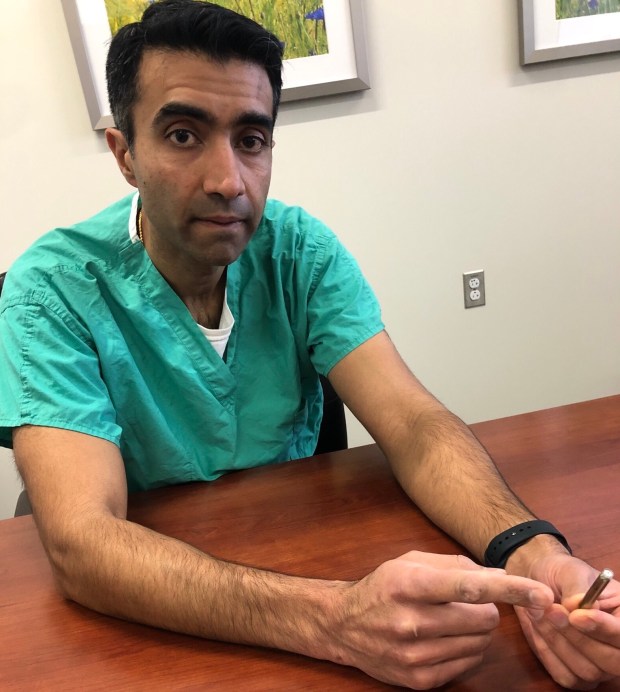Jerry Karzen has had many successes as both a tennis player and a coach. Now he is getting the chance to extend those accomplishments with the assistance of a new generation of pacemaker.
In January, Karzen was one of the first patients to receive a new dual chamber leadless (pronounced LEED-less) pacemaker now offered at Northwestern Medicine Lake Forest Hospital. The device received Food and Drug Administration approval in 2023 and went into use inside the Northwestern medical system last summer.
For Karzen, 71, his journey toward implantation occurred two to three years ago when he noticed his endurance decrease.
“I was getting tired much quicker than I thought I should,” Karzen remembered.
It was a frustrating development for Karzen, a professional tennis player in the 1970s who competed at the sport’s major tournaments, including Wimbledon and the U.S. Open. He later won United States Tennis Academy-sanctioned championships with his children and has coached the New Trier girls’ tennis team to state titles. Plus, he operates his own tennis club in Glenview.
Frustrated with the lack of stamina, Karzen took a series of tests, but they all proved inconclusive. Then, about nine months ago, Karzen underwent a cardiopulmonary stress test that revealed a lower heart rate during intense exercise. He was only reaching 96 beats a minute, when it should have been between 120-130.
Karzen discussed the situation initially with his primary care physician and soon they connected with his friend and fellow tennis player, Dr. Nishant Verma, an electrophysiologist at Lake Forest Hospital.
Verma believed Karzen would be a candidate for the new pacemaker that is about the size of a Triple A battery.
“His main problem was his upper chamber not allowing his heart rate to go fast enough,” he said. “This leadless device can sit in the upper chamber and increase that. Prior leadless devices did not have that capability.”
Verma said one main difference of this pacemaker is that it is inserted through a small incision in the leg and not the arm. He added that in a traditional pacemaker, there is a battery under the skin and then there are wires that connect to that battery. The wires are connected through a vein under the collarbone that leads into the heart and plug it into the battery that is sitting in the chest.
In this case, there aren’t any wires left behind.
“That is a significant advancement because those wires can have issues over time including fracture or they can infected,” he said. “Also, if they have been in for an extended period of time, removing them is quite challenging and has significant risks.”
Verma said these pacemakers are only implanted on the upper and lower right side of the heart chamber.
“This is the first time we have a leadless system that functions exactly the same as a traditional pacemaker, with one unit in the upper chamber of the heart and one unit in the lower chamber, and they are able to communicate with one another.”
He added, “That mimics your natural electrical system because the electrical signal comes from the right upper chamber and goes to the right lower chamber. The two devices are what is quite unique about this. It is pretty slick.”
Another advancement is a much faster recovery time for patients. In traditional pacemakers, a patient can’t carry any more than 10 pounds in the left arm and can’t lift the left elbow over the shoulder for about six weeks.
With Karzen still playing and coaching tennis, a lengthy recovery would have been an issue.
“For you as an athlete this would be a better option and it never existed before,” Verma recalled telling Karzen.
Verma presented the information to Karzen, who acknowledged having some caution due to the lack of time the new pacemaker has been widely available. But he decided to move forward, becoming one of the first to do so at Lake Forest Hospital.
“There is trepidation but eventually you have confidence in the doctors and the people who are doing the procedures,” he said.
In January, Verma inserted the pacemaker into Karzen during an operation that typically lasts two to three hours.
Karzen was back on the tennis court about a week and his recovery continues with his heart rate returning to normal levels.
“I feel like things are better, but there is still a distance to go,” he said. “It wasn’t a magic bullet and I am not 30 again, but it will give me the chance to last longer.”
Verma said the dual-chamber pacemakers might not be right for every patient as it depends on the type of heart issue someone faces. In addition, given its recent debut on the market, safety data is still being collected, and it is yet to be determined how long the device will last.
Yet overall he remains pleased with the initial results in Karzen and his other patients.
Karzen echoes that sentiment hoping he has charted a new recovery path for people facing heart issues.
“I hope it can help me,” Karzen said. “And I hope it can help others.”
Daniel I. Dorfman is a freelance reporter for Pioneer Press.



